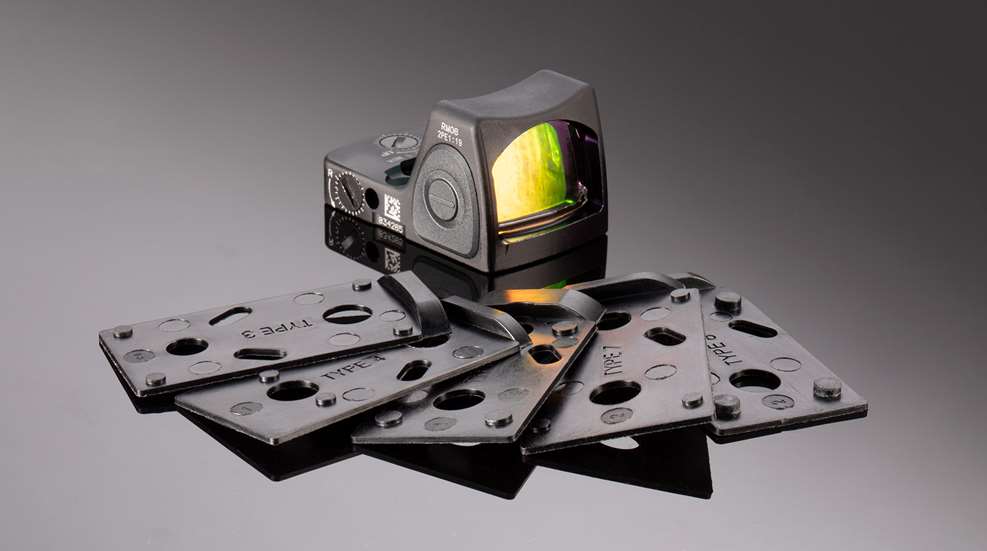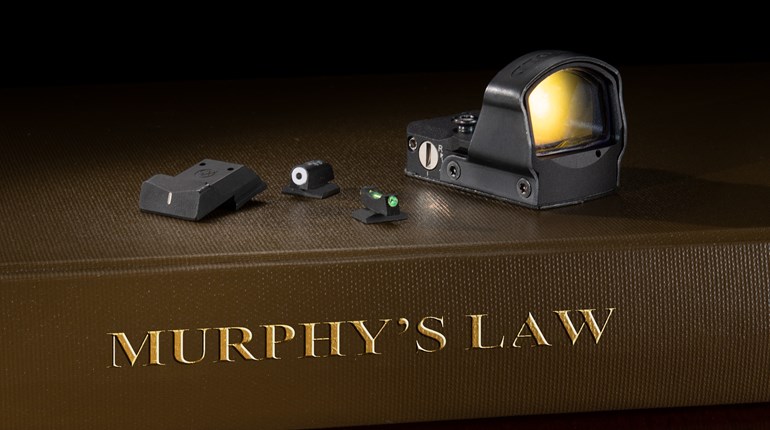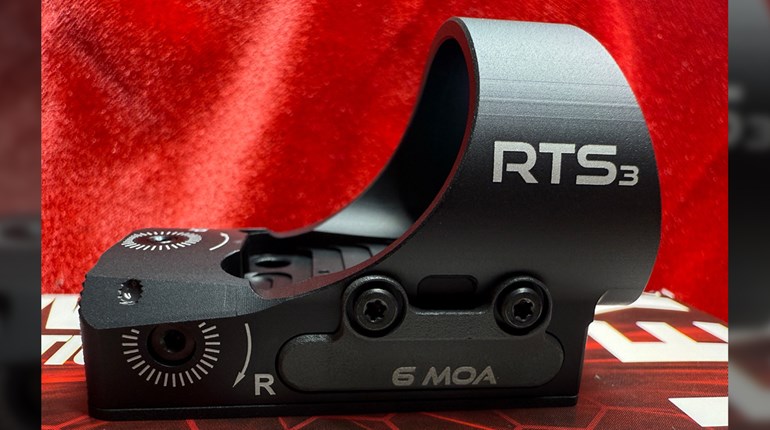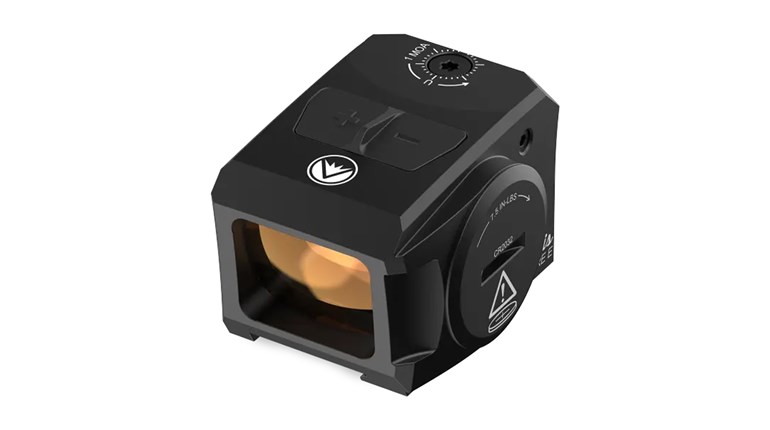
Though workable, adaptor plates are a less-than-ideal solution to fitting myriad MRDS to factory-cut slides. Newer, innovative mounting systems and the gradual standardization of footprints continue to improve the situation.
It’s interesting to note that the original, modern miniaturized optic suitable for mounting on a duty handgun slide—the Trijicon RMR—debuted 14 years ago, followed shortly by people custom machining slides to fit it, and then FN America launching the first pistol with a slide factory-machined to accept a dot just short of a decade ago.
The FNX-45 Tactical came with adaptor plates for either the RMR or the Docter Optic dot sights, because those were the two MRDS in the SOCOM inventory at the time, and the FNX-45 Tactical had grown out of an entrant hoping to win a contract from the U.S. military’s joint door-kicker command.
Intentionally or not, the groundbreaking FN Tactical set a trio of precedents for subsequent factory MRDS-compatible pistols, of which there would soon be plenty.
First, that pistols would be able to accommodate differing footprints of various optical sights. Second, that they would do this via the use of “adaptor plates.” Lastly, that these adaptor plates installed between the slide and the optic would require the use of suppressor-height, back-up iron sights to allow for co-witnessing said irons with the thus-elevated red dot.
It’s interesting that a couple of these didn’t necessarily apply to the big FNX the way people thought they did. For starters, the FNX Tactical had suppressor-height sights because it came from the factory with a threaded barrel and was originally designed with an eye toward filling a military niche not that different than that of Heckler & Koch’s enormous MK23 horse pistol.
Furthermore, the adaptor plate on the FN served a different purpose than those on later efforts from other manufacturers. Since it was only intended to fit two optics, the holes for both were tapped into the top of the FN’s slide and the plate merely blocked off the other two; the optic’s mounting screws still threaded directly into the slide. Some other manufacturers, in an attempt to accommodate as many different footprints as possible, used adaptor-plate systems where the optic mounted to the plate itself, which was then attached to the slide with separate screws.
When used as workarounds to accommodate a slide-mounted dot, both things introduce shortcomings to the usefulness of the pistol.
The elevated sights necessary to function as backup irons are more snag-prone, especially when used without a red dot mounted on the slide. For another, their elevation off the bore axis can cause problems with some shooters being able to use them accurately. Lastly, and specific to the Glock platform where the sights are attached at the front via a tiny screw and nut, the more massive front blade is more prone to departing the firearm when inertia causes its mounting screw to fail.
Speaking of departing the firearm due to inertia, the adaptor-plate systems where the optic mounts to the plate—which is then mounted to the slide—add a whole second set of mounting screws that can fail under recoil. Being mounted on the slide subjects the optic to punishing G-forces as the slide slams fore and aft, and if all the screws aren’t torqued to spec and checked for proper tension routinely (painted witness marks are your friend), your expensive electronic sight might possibly trigger the need for expensive dental work when it flies off the slide under heavy recoil.
Three trends in the maturing MRDS world are happening to mitigate these shortcomings, though.
First, we’re starting to see pistols designed from the ground up to have a slide-mounted dot. This means that the internal components in the slide of pistols like the Springfield Armory Hellcat OSP are arranged such that the sight can be mounted lower, which eliminates the need for the massive shark-fin front sights. Now you only need to put suppressor-height sights on your pistol if you want to use, you know, an actual suppressor.
The second useful trend is the consolidation of footprints. These days when a manufacturer launches a new optic, if they’re clever, they’ll arrange its mounting holes such that it can piggyback off an existing, widely distributed footprint.
We haven’t reached anything like an industry standard as yet, but if I had to bet money, the majority of full-size sights are going to be designed around the Trijicon RMR footprint, while compact models are likely to mate into the cutout for the popular Holosun 507k.
Probably the biggest change will be increased popularity for enclosed-emitter sights. If the regular RMR-type holographic sights had a crucial weakness, it was that the LED emitter that projects the reticle onto the lens is out in the open atop the sight body.
For civilian or even police use, this isn’t that big a deal. But, for military sidearms or pistols carried openly in the woods in inclement weather, there was always the chance of dirt, mud or snow getting into the sight in such a way as to block the emitter.
For this reason, some go-fast dudes experimented with Aimpoint T1s mounted to pistol slides and, not being one to leave money on the table, Aimpoint came up with a dedicated enclosed-emitter pistol optic in the form of its Acro. Of course, this circles us back to the lack of standardized mounts, and for the most part the various enclosed optics used an assortment of proprietary means of fastening them to the slide. This is starting to change, however. For instance, the Holosun EPS Carry will essentially bolt right into a 507k mount, thanks to an enclosure that’s short enough front-to-back to allow the screws to be positioned in the usual place.
Finally, as the number of footprints get reduced and pistols are designed from the start to accept a dot, you’ll see more pistols that accept common footprints mounted right to the slide without requiring an adaptor plate. Alternatively, the Springfield Armory Echelon can accommodate all the most common footprints thanks to an adjustable system of recoil lugs that can be shuffled around in the optics cut.
We are entering a new golden age of dot sights—and, honestly, the timing couldn’t be better, personally, because ain’t nobody’s eyes getting younger over here.





































